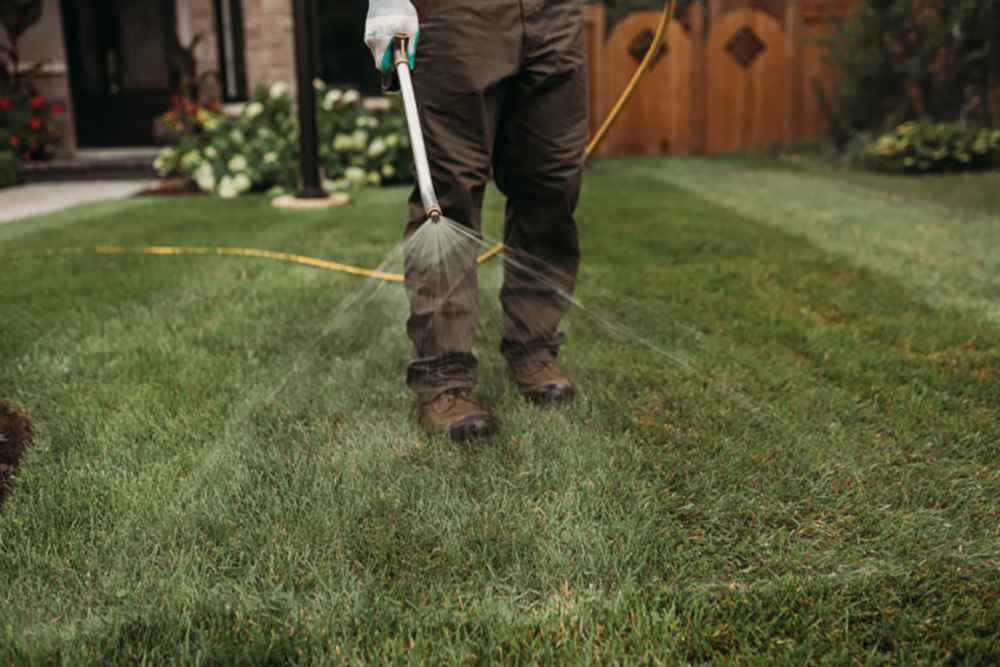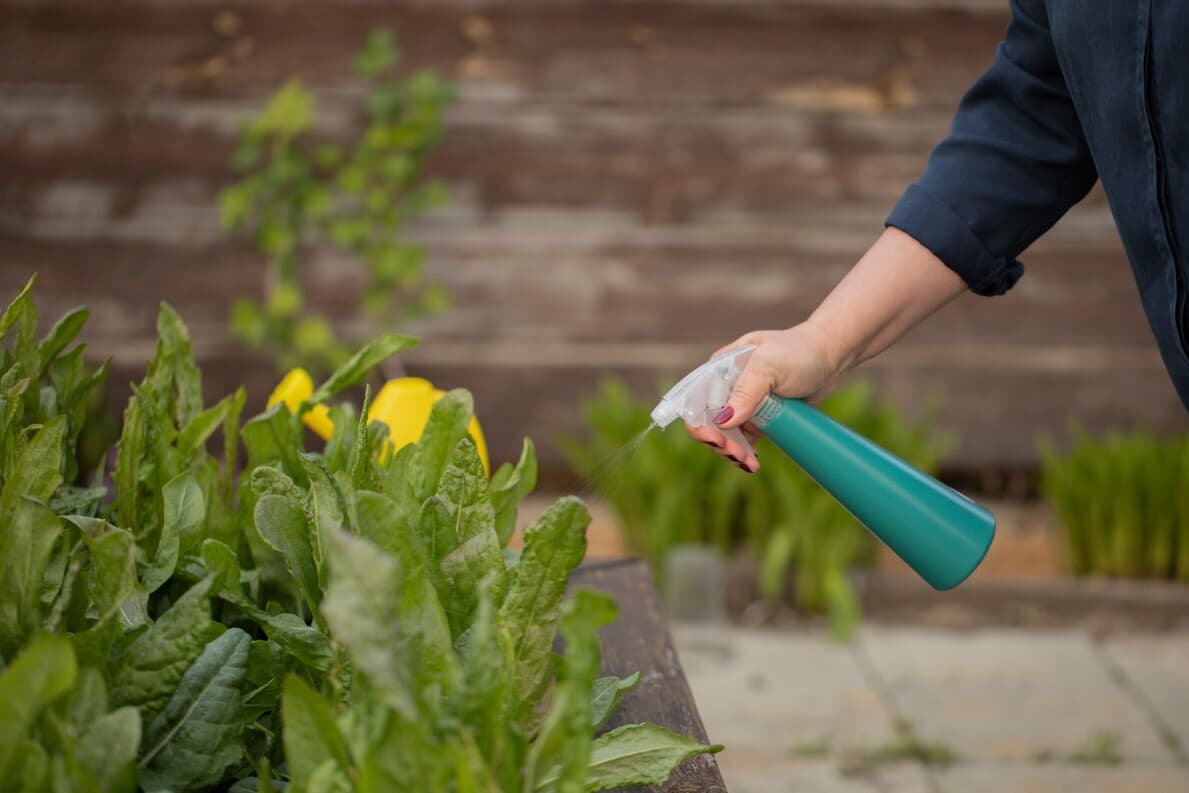Ever walked outside to admire your lawn, only to discover those pesky dandelions and crabgrass have staged an overnight invasion? We’ve all been there. At Turf Medic, we’ve met countless homeowners across Greencastle and the Pennsylvania/Maryland border region who share this frustration. They spend weekends pulling weeds, buying expensive store products, and still end up disappointed when those unwanted plants return with a vengeance.
A healthy, weed-free lawn doesn’t happen by accident—it’s created through consistent care and the right approach.
The challenge of maintaining a weed-free lawn while being environmentally conscious isn’t just about curb appeal – it’s about creating a safe, usable outdoor space for your family. With growing concerns about the impact of harsh chemicals on our children, pets, and local water systems, more homeowners are asking us about natural weed control solutions that actually work.
In this guide, we’re going to share the most effective natural weed control solutions we’ve developed through years of serving local lawns in our community. From prevention strategies that stop weeds before they start, to DIY methods you can try this weekend, to professional organic approaches that deliver long-term results – we’ve got you covered with practical, proven advice for your Pennsylvania lawn.
Understanding Weeds in Pennsylvania Lawns
Before we dive into solutions, let’s talk about why your Pennsylvania lawn might be struggling with weeds in the first place. Our local Greencastle area presents some unique challenges when it comes to weed control.
The most common weed types we encounter in this region include:
- Dandelions – Those bright yellow flowers might look cheerful, but their deep taproots and windborne seeds make them persistent invaders
- Crabgrass – Thrives in our hot summer months, especially in thin or stressed lawn areas
- Clover – While not always considered problematic, clover can quickly take over nitrogen-poor soil
- Plantain – Those broad-leafed weeds that seem to pop up in compacted soil areas
- Chickweed – A winter annual that starts growing in fall and flowers in early spring
- Nutsedge – Those light green, fast-growing grassy weeds that seem to laugh at most control methods
What many homeowners don’t realize is that weeds follow predictable seasonal patterns in our Pennsylvania climate. Spring brings dandelions and chickweed, summer heat welcomes crabgrass and nutsedge, while fall introduces different broadleaf varieties. Each season requires different prevention and treatment approaches.
Weeds aren’t random invaders—they’re telling you something important about your soil and lawn conditions.

Why do weeds seem to thrive while your grass struggles? It comes down to survival advantages. Weeds are opportunists – they exploit weaknesses in your lawn. Common conditions that give weeds the upper hand include:
- Compacted soil that grass roots can’t penetrate but weed roots can
- Improper mowing heights that stress grass and create sunlight opportunities for weeds
- Incorrect watering practices that favor shallow-rooted weeds over deep-rooted grass
- Soil pH imbalances that limit nutrient availability for grass
- Thin lawn areas from winter damage, insect problems, or disease
We’ve seen so many customers waste hundreds of dollars on store-bought chemical solutions that promise quick results but deliver disappointment. These products often:
- Treat symptoms rather than addressing underlying lawn health issues
- Require perfect application conditions and timing that’s easy to miss
- Contain broad-spectrum herbicides that can damage desirable plants
- Create resistant weed populations that become harder to control over time
- Wash away in rain, potentially entering local watersheds
Understanding these limitations explains why many homeowners feel stuck in a costly cycle of treating the same weed problems year after year. The good news? Natural weed control solutions can break this cycle by strengthening your lawn’s natural defenses while addressing weeds in ways that don’t compromise your family’s health or the environment.
Top Natural Weed Control Solutions for Homeowners
Prevention as the Best Natural Weed Control Solution
We’ve always told our customers that the best weed control doesn’t come from a bottle – it comes from building such a thick, healthy lawn that weeds simply can’t compete. Prevention is truly your most powerful natural weed control solution.
The single most effective weed control strategy is a thick, healthy lawn that outcompetes invaders naturally.
Proper Mowing Techniques
One of the most common mistakes we see in the Greencastle area is cutting grass too short. When you mow your lawn below 3 inches, you’re essentially rolling out the welcome mat for weeds. Taller grass:
- Shades the soil surface, preventing weed seeds from germinating
- Develops deeper root systems that access water lower in the soil
- Outcompetes emerging weed seedlings for nutrients and light
- Recovers faster from stress and damage
We recommend keeping your mowing height at 3-4 inches during the growing season, and never removing more than one-third of the grass blade at once. Also, keep those mower blades sharp! Dull blades tear rather than cut, creating entry points for disease.

Optimal Watering Practices
When it comes to watering, more isn’t better – smarter is better. Frequent shallow watering encourages shallow root systems and creates ideal conditions for weeds like crabgrass. Instead:
- Water deeply but infrequently (1-1.5 inches once or twice a week)
- Water early in the morning to reduce evaporation and fungal disease risk
- Consider a simple rain gauge to track natural rainfall amounts
- Adjust seasonal watering based on temperature and natural precipitation
During our hot Pennsylvania summers, lawns may naturally go dormant and turn slightly brown – this doesn’t mean they need more water! Overwatering during this period can encourage summer weeds while stressing your grass.
Soil Testing and pH Balancing
We can’t stress enough how important soil is to natural weed control. Most Pennsylvania soils tend toward acidity, which limits nutrient availability and favors certain weeds. A simple soil test can reveal:
- Your soil’s pH level (grass prefers 6.0-7.0)
- Which nutrients your soil lacks
- How much organic matter is present
- Recommendations for organic amendments
Based on soil test results, you might need to apply lime to raise pH, add compost to improve structure, or incorporate organic fertilizers to address specific nutrient deficiencies. These adjustments create optimal conditions for grass while making the environment less hospitable to weeds.
Overseeding Strategies
Nature abhors a vacuum, and your lawn is no exception. Any bare spot is an invitation for weeds, which is why overseeding is such a powerful preventive solution. In our Greencastle region:
- Early fall (late August to mid-September) is ideal for overseeding cool-season grasses
- Choose grass seed varieties adapted to local conditions (Kentucky bluegrass, perennial ryegrass, and fine fescue blends work well)
- Prepare the area by removing debris and lightly scratching the soil surface
- Keep newly seeded areas consistently moist until established
We often recommend overseeding even healthy lawns every 2-3 years to introduce newer, more resilient grass varieties and maintain thick coverage that naturally suppresses weeds.
DIY Natural Weed Control Solutions
Sometimes prevention isn’t enough, and you need to take direct action against existing weeds. Here are some effective DIY natural weed control solutions you can implement this weekend:
Natural doesn’t mean ineffective—it means working with nature’s systems instead of against them.
Vinegar-Based Solutions
Common household vinegar (5% acetic acid) can be effective against young weeds with undeveloped root systems. For stronger results:
- Use horticultural vinegar (20-30% acetic acid) for tougher weeds, but handle with extreme caution as it can cause skin burns
- Add 1 tablespoon of dish soap per gallon to help the solution stick to weed leaves
- Apply on hot, sunny days when no rain is forecast for at least 24 hours
- Be precise in application as vinegar solutions will damage any plant they contact
- Expect to reapply multiple times for persistent weeds
Remember that vinegar only kills the above-ground portion of weeds, so it’s most effective on annual weeds or very young perennials.

Boiling Water Techniques
Sometimes the simplest solutions are the most effective. Boiling water works well for weeds in sidewalk cracks, gravel driveways, and other non-lawn areas:
- Bring a kettle of water to a rolling boil
- Carefully pour directly onto the weed’s crown (the central growing point)
- Be precise to avoid damaging nearby desirable plants
- Use for isolated weeds rather than large infestations
This method is particularly effective for dandelions and other taprooted weeds, essentially cooking their growing points and disrupting their ability to photosynthesize.
Corn Gluten Meal as Pre-emergent
One of our favorite natural pre-emergent weed controls is corn gluten meal, a byproduct of corn processing:
- Apply in early spring just as forsythia begins blooming (typically early-mid April in our area)
- Use 20 pounds per 1,000 square feet of lawn area
- Water lightly after application, then allow to dry thoroughly
- Reapply in late summer (August) to prevent winter annual weeds
Corn gluten meal works by inhibiting root formation in germinating seeds. As an added benefit, it contains about 10% nitrogen, so it feeds your lawn while preventing weeds. However, timing is crucial – it won’t affect weeds that have already sprouted.
Hand-Pulling Strategies and Tools
Sometimes there’s no substitute for the direct approach. Effective hand-pulling:
- Works best when soil is moist, such as after rain or morning dew
- Requires removing the entire root system, particularly for taprooted weeds
- Should include disposing of pulled weeds away from your lawn (especially if they’ve gone to seed)
Invest in quality weeding tools like:
- Long-handled weed pullers that remove roots without bending
- Dandelion diggers (also called weed fisters) for deep-rooted weeds
- Hoes and cultivation tools for weeds in garden beds
- Weed torches for gravel areas and hardscape cracks (use with appropriate caution)
Hand-pulling might seem old-fashioned, but it remains one of the most effective targeted approaches for manageable weed problems.
Professional Natural Weed Control Solutions
While DIY methods can be effective for moderate weed issues, sometimes professional intervention delivers better results with less effort. At Turf Medic, we’ve developed comprehensive natural weed control programs that combine the best organic practices with our local expertise.
Organic Treatments Available Through Professionals
Professional-grade organic weed control options include:
- Chelated iron products that target broadleaf weeds while sparing grass
- Concentrated botanical oils that disrupt weed cell structures
- Organic pre-emergent barriers using corn gluten or other natural materials
- Beneficial nematodes and microbial solutions that target specific weed types
These products often require professional application equipment, precise timing, and expert knowledge to be effective. Many aren’t available to homeowners or require special licensing to purchase.
Benefits of Professional Assessment
One of the biggest advantages of professional service is accurate identification and customized treatment:
- Proper weed identification ensures the right approach for each species
- Soil testing with professional interpretation identifies underlying issues
- Trained eyes recognize early signs of problems before they become severe
- Local experience means understanding neighborhood-specific challenges
Many homeowners waste time and money treating the wrong problems or using ineffective approaches. Our professional assessments eliminate guesswork and create targeted solutions.
Long-term Natural Weed Management Programs
Rather than one-time treatments, we recommend comprehensive programs that address your lawn’s health throughout the year:
- Early spring treatments focused on preventing summer annual weeds
- Late spring applications targeting broadleaf weeds
- Summer treatments addressing stress factors that create weed opportunities
- Fall applications to strengthen grass and prevent winter/spring weeds
- Winter planning and preparation for the following season
These coordinated approaches build on each other, creating increasingly weed-resistant lawns over time.
Cost Comparison: DIY vs. Professional Natural Solutions
While professional services require financial investment, they often provide better value when considering:
- The cost of purchasing multiple DIY products that may or may not work
- The value of your time spent researching, applying, and monitoring treatments
- The effectiveness of professional-grade products not available to consumers
- The long-term benefits of expert application and timing
- The satisfaction of consistent results without trial and error
Many of our clients find that professional natural lawn care actually costs less over time than the cycle of purchasing products, seeing limited results, and trying something new each season.
The Environmental Impact of Natural vs. Chemical Weed Control
Beyond effectiveness, there are compelling reasons to choose natural weed control solutions related to environmental and health considerations.
What you put on your lawn ultimately affects your family, your pets, your water, and your community.

Safety for Children and Pets
We’ve heard too many stories from concerned parents and pet owners about:
- Children developing respiratory issues after playing on chemically treated lawns
- Pets suffering from unexplained illnesses following lawn treatments
- The anxiety of keeping family members off the lawn after chemical applications
Natural solutions eliminate these concerns. Most organic treatments are safe for children and pets to walk on immediately after application, with no worry about chemical residues on shoes, paws, or skin.
Water Quality Considerations
What happens on your lawn doesn’t stay on your lawn. Here in the Pennsylvania/Maryland border region, we’re part of important watersheds that eventually feed into the Chesapeake Bay. Consider:
- Chemical herbicides can leach into groundwater or run off into streams
- Excess fertilizers contribute to algal blooms and aquatic dead zones
- Natural alternatives break down into harmless components
- Healthy lawns with good soil structure naturally filter rainwater
By choosing natural weed control, you’re protecting not just your family but our shared water resources.
Beneficial Insect Preservation
Chemical weed control products rarely affect only their target species. Many also harm:
- Pollinators like bees and butterflies
- Beneficial soil organisms like earthworms
- Predatory insects that keep pest populations in check
Natural lawn care preserves this biodiversity, creating a balanced ecosystem that becomes increasingly self-regulating over time.
Long-term Soil Health
Perhaps the most significant environmental benefit is soil health. Chemical approaches often treat soil as merely a medium to hold plants upright, while natural approaches recognize soil as a living ecosystem:
- Organic matter builds soil structure and water-holding capacity
- Beneficial microorganisms create natural disease suppression
- Mycorrhizal fungi extend grass root systems and improve nutrient access
- Healthy soil biology naturally breaks down thatch and organic debris
Chemical treatments can disrupt these natural processes, creating dependency on additional products to compensate. Natural approaches foster self-sustaining soil health that improves year after year.
Common Mistakes in Natural Weed Control
Even with the best intentions, we see homeowners make several common mistakes when attempting natural weed control. Avoiding these pitfalls will significantly improve your results:
Timing Errors
Natural solutions are often more timing-sensitive than chemical alternatives:
- Applying pre-emergents too late (after weeds have germinated)
- Hand-pulling perennial weeds when they’re setting seed (spreading the problem)
- Using natural herbicides during cool weather when they’re less effective
- Overseeding during inappropriate seasons when grass struggles to establish
Success with natural methods requires understanding weed life cycles and scheduling interventions at vulnerable points in their development.
Improper Application Techniques
Even the best natural solutions fail when improperly applied:
- Diluting concentrates incorrectly (often making solutions too weak)
- Uneven coverage leading to missed areas
- Applying during windy conditions causing drift onto desirable plants
- Using the wrong tools or methods for specific weed types
Follow product instructions carefully and invest in appropriate application equipment for best results.
Unrealistic Expectations
Perhaps the biggest mistake is expecting immediate, perfect results:
- Natural solutions often work more slowly than chemical alternatives
- Some approaches show incremental rather than dramatic improvement
- Complete elimination of all weeds isn’t a realistic (or necessary) goal
- True success should be measured in overall lawn health, not just weed counts
We encourage our clients to view natural weed control as a journey toward a healthier lawn ecosystem, not a one-time fix.
Incomplete Approaches
Finally, many homeowners focus exclusively on killing weeds without addressing why their lawn is vulnerable to weeds in the first place:
- Treating visible weeds without improving soil conditions
- Ignoring cultural practices like proper mowing and watering
- Failing to overseed thin areas
- Not addressing drainage or compaction issues
The most successful natural weed control combines multiple approaches into a comprehensive system tailored to your specific lawn conditions.
Conclusion
So what is the best natural weed control solution for your Pennsylvania lawn? The truth is, there isn’t a single answer that works for everyone. The most effective approach combines prevention through good cultural practices, targeted DIY interventions for minor problems, and professional support for comprehensive lawn health. Our experience serving the Greencastle area has shown us that sustainable, natural lawn care isn’t just possible – it often delivers superior results to chemical-dependent approaches, creating a lawn that’s safe for your family, friendly to the environment, and increasingly resistant to weed problems over time.
Ready to explore natural weed control solutions for your property? Visit our weed control page or contact Turf Medic today to schedule a consultation. Our team understands the specific challenges Pennsylvania homeowners face and is committed to providing effective natural solutions tailored to our unique local conditions. Whether you’re looking to implement some DIY techniques or prefer the convenience of professional service, we’re standing by to help you achieve the lawn of your dreams – naturally.
